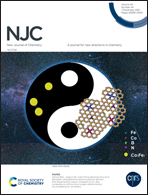Room temperature ethanol gas-sensing properties based on Ag-doped MoSe2 nanoflowers: experimental and DFT investigation
Abstract
An Ag-doped MoSe2 nanomaterial-based sensor was fabricated for ppb-level ethanol sensing at room temperature. The MoSe2 and Ag-modified MoSe2 nanoflowers were synthesized by a hydrothermal method, which exhibited high purity and crystallinity. Some characterization techniques such as SEM, TEM, XRD and XPS were employed to comprehensively analyze the micromorphology and microstructure of the Ag–MoSe2 sample. The Ag-modified MoSe2 nanomaterial was composed of nanoflowers assembled with many nanosheets. The gas-sensing results confirmed that compared with pristine MoSe2, the Ag-modified MoSe2 based sensor exhibited a low detection limit (10 ppb) and good response/recovery characteristics towards ethanol at room temperature, which could be used for alcohol testing on drinkers. To further verify and explain the sensing mechanism, pristine and Ag-doped MoSe2 adsorption configurations were simulated via the first-principles study based on density functional theory (DFT). Interestingly, the Ag–MoSe2 system exhibited excellent ethanol sensing performance compared with the pristine MoSe2 system, which was consistent with the experimental results. This work presents the combination of experimental and DFT simulation to substantiate that Ag-doped MoSe2 nanoflowers are promising candidates for low-concentration ethanol detection at room temperature.



 Please wait while we load your content...
Please wait while we load your content...